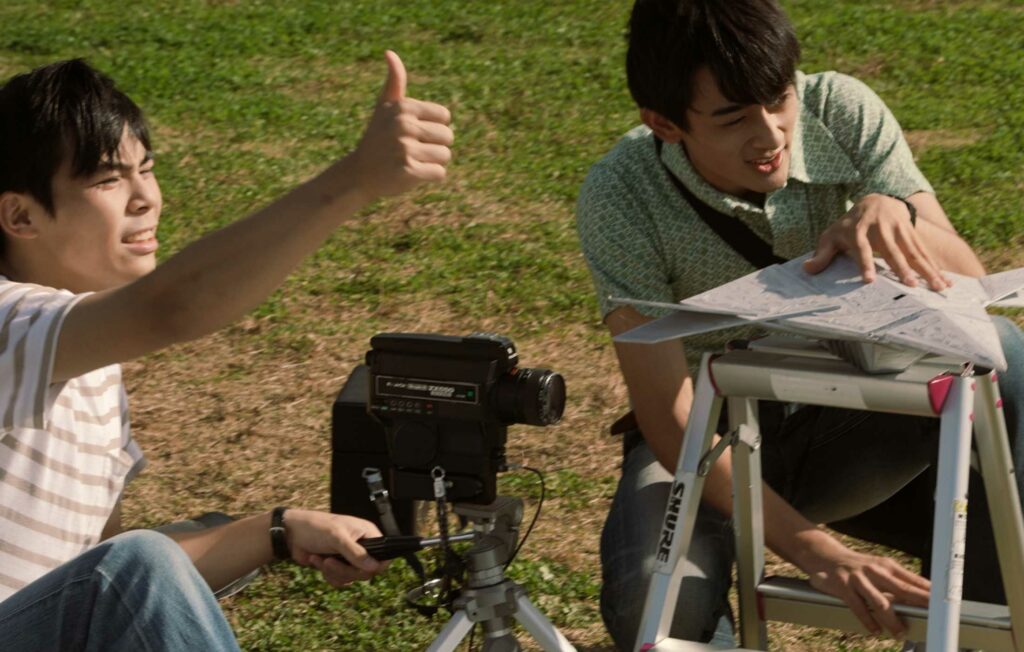I saw Kazuya Konaka’s Single8 on a recent trip to Japan and, upon leaving the theatre, professed my hope that it’d be discovered by international audiences—namely those interested in movies about moviemaking. Following the dismal distribution of Steven Spielberg’s The Fabelmans some months ago, there might be a suspicion within me that films about young people with cameras face a steep uphill battle—perhaps even more so when produced by lesser-known foreign directors. How unfortunate if that’s true, for Konaka’s picture—about high schoolers making a sci-fi movie in late-’70s Japan—is one of the most wonderful recent titles of its kind. It’s been praised by top Japanese directors such as Hirokazu Kore-eda and Kiyoshi Kurosawa. And viewed in an age where lavish home movies can be assembled on cell phones and computers, a picture like this reminds one of the deeper merits of filmmaking and what individuals can accomplish through dedication.
Single8 begins with exposition text modelled after the opening of Star Wars (1977), describing how the aforementioned American blockbuster dazzled Japanese audiences after being imported in 1978. The camera appropriately pans across a starfield to a planet—just before a spaceship drifts in from above the lens. However, instead of an enormous, professionally crafted model, the vessel is a paper mock-up clenched in the (visible) hands of a teenager named Hiroshi (Yuu Uemura), who simulates the engine noise with his voice. Infatuated with Star Wars and aided by his friend Yoshio (Noa Fukuzawa), he sets about recreating the film’s opening with a bigger homemade model and a Super 8 camera. Meanwhile, a film student employed at a local camera shop (Yusuke Sato) offers advice on combating exposure problems (after a whole day’s work is ruined due to improper camera settings). Through much trial and error, they achieve the shot they want and subsequently propose making a short film for their school’s Cultural Festival. Hiroshi even persuades his crush (Akari Takaishi) to play the heroine.
Director Konaka, who also wrote the script (based on his own childhood experiences making Super 8 movies; boyhood projects of his play during the end credits), has gone the distance in recreating the 1970s zeitgeist wherein teenage moviemakers had to—among other things—wait three days for film rolls to be developed, record audio in post-production, and create special effects in-camera. The “making-of” sequences are particularly enjoyable: the protagonists simulate spaceships emerging from clouds by lifting models from steaming baths, levitating objects with strings, and creating “time reversal” with actors walking backwards amid unknowing pedestrians and looping the footage in reverse. In another (amusing) moment, they recruit a shy university student to animate rays by physically etching them onto the film strips one frame at a time. The results are a fun nostalgic glimpse into a time before one could join images at home with computer software.
More importantly, Konaka has provided a story about the creative process and embodied it through a steadily developing protagonist. At the start, Hiroshi is a self-described no-talent interested only in recreating an image from the latest American movie; as the drama progresses, he becomes an attentive director (telling his actors in one instance to wait for the right lighting; he wants a lens flare) and is challenged to use his spaceship in a fleshed-out screenplay, one that leaves viewers something to think about. (A friend of his paraphrases the often-quoted passage from Akira Kurosawa’s autobiography that a good film can never be fashioned from a lousy script.) By drama’s end, Hiroshi’s become so involved in the filmmaking process that he wonders, were his own life a scripted narrative, if he’s undergone a character arc; and he confidently remarks that his next movie will be even better.
Kazuya Konaka’s past efforts include sci-fi television, and Single8 contains numerous references to otaku culture (a scene in the protagonists’ movie is inspired by the original Ultraman show; Hiroshi has a Toshiro Mifune model and numerous kaiju figures on his shelf) amid a fast-moving story populated by likeable characters with a terrific sense of camaraderie. In what recalls Spielberg’s The Fabelmans, an actor is instructed to walk into the distance for a closing shot, and he keeps going even after the director yells, “Cut!” Except whereas Spielberg used this scenario for emotional effect, Konaka does it for smiles (the actor simply cannot hear his comrades over the wind), his bemused friends chasing after him to inform him the scene has wrapped. The entire cast gives relaxed, natural performances. Especially memorable is the unconventionally attractive Akari Takaishi as Hiroshi’s crush, and the film appropriately resolves her dynamic with Hiroshi in a manner that is neither disappointing nor sentimental. Kenichi Aikawa’s cinematography is appealingly bright and crisp, and Peter Michi Miyazaki has contributed one of the most wonderful film scores of recent memory. (His main theme and its many variants are worth seeing the movie for alone, and was enough to keep me glued to my seat through the end credits.)
As of this writing, Single8 has made appearances at the 2023 Boston SCI-FI, Sci-Fi Horror, and Buenos Aires Rojo Sangre Film Festivals, and it is my hope that it’ll continue moving abroad and garner the international attention it deserves. Kazuya Konaka and his team have turned out one of the most splendid recent movies about creatives; after three watches, I can confidently say it is one of those rare movies that gets better each time out. Konaka had said, “I’ve always wanted to make a film about those days when I was obsessed with making 8mm films. Watching movies is fun, but making them is even more fun. I want to make a movie that the audience can relate to.” He has succeeded in spades.


